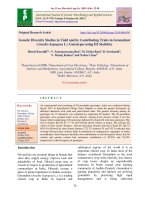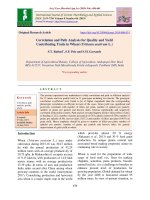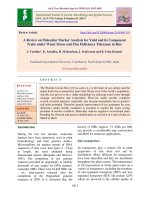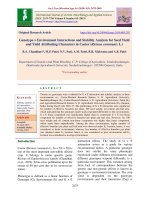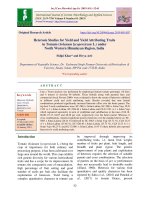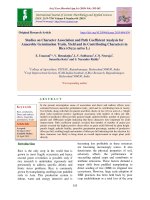Correlation and path coefficient analysis for yield and yield attributing characters in chilli (Capsicum annum L.) genotypes
Bạn đang xem bản rút gọn của tài liệu. Xem và tải ngay bản đầy đủ của tài liệu tại đây (203.23 KB, 4 trang )
Int.J.Curr.Microbiol.App.Sci (2018) 7(1): 3265-3268
International Journal of Current Microbiology and Applied Sciences
ISSN: 2319-7706 Volume 7 Number 01 (2018)
Journal homepage:
Original Research Article
/>
Correlation and Path Coefficient Analysis for Yield and Yield Attributing
Characters in Chilli (Capsicum annum L.) Genotypes
C. Vidya*, V.S. Jagtap and N. Santhosh
Department of Horticulture, College of Agriculture, Vasantrao Naik Marathwada Krishi
Vidhyapeeth, Parbhani- 431 402 (M.S.) India
*Corresponding author
ABSTRACT
Keywords
Correlation, Path
coefficient analysis,
Chilli, Yield
Characters
Article Info
Accepted:
26 December 2017
Available Online:
10 January 2018
A field experiment entitled “Biometrical studies in chilli (Capsicum annum.L) carried out
in RBD Design with three replication during the Kharif season 2016, at Instructional Cum- Research Farm, Department of Horticulture ,College of Agriculture, Latur,
V.N.M.K.V., Parbhani. The correlation and path analysis were studied in twenty genotypes
in chilli for 14 different qualitative and quantitative characters . Correlation coefficiants at
genotypic and phenotypic level indicated that plant spread, fruit length, fruit diameter, fruit
stalk length showed highly significant and positive genotypic and phenotypic correlation
coefficient with fruit yield per plant. Reducing and non- reducing sugar showed highly
significant and positive genotypic and phenotypic correlation coefficient with total sugar.
Path coefficient analysis revealed that plant spread, fruit diameter, weight of seeds per
fruit, was found positive and direct effect on fruit yield per plant, while stem girth, primary
branches, days to first flowering was found high negative direct effect on fruit yield per
plant. Fruit diameter was very high positive direct effect on fruit yield per plant. Stem girth
and primary branches had very high negative direct effect on fruit yield per plant. Plant
spread and weight of seeds per fruit was medium positive direct effect on fruit yield per
plant. Days to first harvesting had low positive direct effect on fruit yield per plant. Plant
height and days to first harvesting had negligible effecton fruit yield per plant.
Introduction
in simultaneous selection for more than one
character.
Yield is a complex character controlled by the
large number of contributing characters and
their interaction. It is not only influenced by a
number of related characters which are
governed by few numbers of genes, but is also
influenced to a greater extent by environment.
The study of correlation coefficients will helps
As the yield is dependent on many component
characters, the total correlation is insufficient
to explain the true association between the
characters. In order to have clearer picture of
yield components for effective selection
programme, it would be desirable to consider
3265
Int.J.Curr.Microbiol.App.Sci (2018) 7(1): 3265-3268
the relative magnitude of various characters.
Path coefficient analysis will help for sorting
out the total correlation into direct and indirect
effects which is useful in selecting high
yielding genotypes.
Considering the importance of the crop there
is need to generate more information on nature
and magnitude of variability for yield and
other characters present in germplasm pool as
it is an important basic pre-requisite for
starting any systematic breeding programme
in identifying superior lines or varieties.
Materials and Methods
The present investigation was carried out at
Instructional
-Cum
-Research
Farm,
Department of Horticulture, College of
Agriculture, and Latur during Kharif season of
July 2016 to February 2017. The statistical
design adapted was RBD with two
Replications.
Chilli
seedlings
were
th
transplanted on 22 August, 2016 at the
spacing of 60 cm x 45cm.
In each treatment there were twenty plants of
each genotype in a replication. Five plants
were randomly selected from each treatment
to record observations The experimental
material comprised of 20 genotypes viz.,
Guntur local, Phule jyothi, DCC-127,DCC167, DCC-36, DCC-25, DCC-50, DCC-135,
DCC-168, DCC-164,Pusajwala, Byadagi
Dabbi, Byadagi Kaddi, Parbhani Tejas, Jalna
Local, G-4, Beed
Local-1,BeedLocal2,Hingoli Local and PBNC-1 were used.
Observations on growth, yield, and quality
characters were recorded on five randomly
selected plants in each treatment.
Plant height, Plant spread, Primary branches,
Stem girth, Days to first flowering, Days to
50% flowering, Days to first harvesting, Fruit
length, Fruit diameter, Pericarp thickness,
Fruit stalk length, Weight of seeds per fruit,
Number of fruits per plant (green), Yield per
plant(green).
The Phenotypic correlation coefficient and
genotypic
correlation
coefficient
and
genotypic correlation coefficient and direct
and indirect effects were computed by using
procedure given by Dewey and Lu (1959).
Results and Discussion
Plant spread, fruit length, diameter of fruit
showed highly significant and positive
genotypic
and
phenotypic
correlation
coefficients with fruit yield per plant.
Reducing and non-reducing sugar showed
highly significant and positive genotypic and
phenotypic correlation coefficient with total
sugar. Ascorbic acid is highly significant and
positive correlation with T.S.S.
Path coefficient analysis revealed that, fruit
diameter, weight of seeds per fruit, plant
spread, and number of fruits per plant green
found positive and direct effect on fruit yield
per plant. While, stem girth and days to first
flowering was found negative and direct effect
on fruit yield per plant.
Diameter of fruit showed very high positive
direct effect on fruit yield per plant. Stem girth
had very high negative direct effect on fruit
yield per plant. Plant spread was medium
positive direct effect on fruit yield per plant.
Days to first harvest had low positive direct
effect on fruit yield per plant.
From the present path analysis study in chilli,
it may be concluded that improvement in fruit
yield per plant could be brought by selection
for component characters like number of fruits
per plant, plant spread, and number of primary
branches per plant (Table 1 and 2).
3266
Int.J.Curr.Microbiol.App.Sci (2018) 7(1): 3265-3268
Table.1 Genotypic and phenotypic correlation coefficient for different yield contributing
characters in chilli
Sl.
No
1
2
3
4
5
6
7
8
9
10
11
12
13
14
1
2
3
4
5
6
7
8
9
10
11
12
13
14
1.000
0.375*
1.000
-0.012
-0.068
1.000
-0.15
0.086
0.311
1.000
0.287
0.021
-0.244
-0.944**
1.000
0.308
0.133
-0.029
0.233
-0.158
1.000
0.005
0.125
0.028
0.286
-0.269
0.672*
1.000
0.123
0.090
0.045
0.319*
-0.209
-0.039
-0.338*
1.000
0.223
0.456**
-0.121
0.071
0.099
0.067
-0.252
0.309
1.000
-0.087
-0.01
0.420*
0.425*
-0.29
0.283
0.780**
-0.252
-0.041
1.000
-0.163
0.043
0.275
0.366*
-0.266
0.333*
0.312*
0.162
0.165
0.564**
1.000
-0.165
0.088
0.260
0.242
-0.923**
0.255
0.333*
0.227
0.061
0.396*
0.354*
1.000
-0.369*
-0.226
0.318*
-0.145
-0.025
-0.464**
-0.144
0.233
-0.265
-0.205
-0.351*
-0.169
1.000
0.262
0.656**
-0.149
0.277
-0.112
0.266
0.045
0.429**
0.859**
0.030
0.250
0.256
-0.230
1.000
*significant at p = 0.05 probability (0.312)
**significant at p = 0.01 probability (0.403)
1. Plant height (cm) 5. Days to first flowering 9. Fruit diameter (mm)
13. Number of fruits per plant (green)
2. Plant spread (cm) 6. Days to 50% flowering 10. Pericarp thickness (mm) 14. Yield per plant (green)
3. Primary branches 7. Days to first harvesting 11. Fruit stalk length (cm)
4. Stem girth (mm) 8. Fruit length (cm)
12. Weight of seeds per fruit
Table.2 Direct (diagonal) and indirect effects of yield components on fruit yield at a genotypic
level in chilli
1
2
3
4
5
6
7
8
9
10
11
12
13
1
2
3
4
5
6
7
8
9
10
11
13
12
0.048
0.117
0.002
0.048
-0.042
0.043
0.002
0.022
0.152
-0.006
-0.012
-0.050
-0.061
0.018
0. 312
0.011
-0.027
-0.030
0.019
0.005
0.016
0.312
-0.008
0.003
0.027
-0.037
-0.006
-0.0214
-0.170
-0.100
0.035
-0.004
-0.001
0.008
-0.083
0.031
0.020
0.079
0.053
-0.007
0.027
-0.053
-0.322
0.138
0.033
0.011
0.057
0.049
0.032
0.027
0.307
-0.024
0.014
0.006
0.041
0.304
-0.146
-0.022
-0.011
-0.037
0.068
-0.220
-0.020
-0.283
-0.025
0.015
0.041
0.005
-0.070
0.020
0.142
0.027
-0.007
0.046
0.021
0.025
0.078
-0.077
0.003
0.039
-0.004
-0.092
0.039
0.095
0.041
-0.061
-0.172
0.059
0.023
0.102
-0.024
0.060
0.028
-0.007
-0.102
-0.030
0.005
0.014
0.180
0.211
-0.019
0.012
0.069
0.039
0.010
0.142
0.020
-0.023
-0.014
0.009
-0.010
0.055
0.684
-0.003
0.012
0.019
-0.0443
-0.004
-0.003
-0.071
-0.137
0.042
0.040
-0.032
-0.045
-0.028
0.075
0.042
0.121
-0.030
-0.008
0.013
-0.047
-0.118
0.039
0.047
0.012
0.029
0.113
0.042
0.074
0.108
-0.058
-0.008
0.027
-0.044
-0.323
0.135
0.036
0.013
0.041
0.042
0.030
0.026
0.306
-0.028
rG
-0.018
-0.070
-0.054
0.047
0.003
-0.066
-0.006
0.042
-0.181
-0.015
-0.026
-0.052
0.167
Residual effect = 0.250
*significant at p = 0.05 probability (0.312)
**significant at p = 0.01 probability (0.403)
Bold: Direct effect above and below diagonal: Indirect effect
1. Plant height (cm)
2. Plant spread (cm)
3. Primary branches
4. Stem girth (mm)
5. Days to first flowering 9. Fruit diameter (mm)
13. Number of fruits per plant (green)
6. Days to 50% flowering 10. Pericarp thickness (mm) rG Correlation with Yield per plant (green)
7. Days to first harvesting 11. Fruit stalk length (cm)
8. Fruit length (cm)
12. Weight of seeds per fruit
3267
0.262
0.656
-0.149
0.277
-0.112
0.266
0.045
0.429
0.859
0.030
0.250
0.025
-0.230
Int.J.Curr.Microbiol.App.Sci (2018) 7(1): 3265-3268
References
Acharya, P. and Rajput, C. B. S., 2003,
Variability and correlation studies for
different traits in Capsicum with respect
to leaf curl complex. Indian J. Hort.,
60(4): 381-387.
Amit K, Ahad I, Kumar V, Thakur S., 2014.
Genetic variability and correlation
Studies for growth and Yield characters
in chilli (Capsicum annuum.). J. Spices
and Arom. Cr 23 (2):170-177.
Ajjappalavara, P. S., Patil, S. S., Hosmani, R.
M., Patil, A. A. and Gangaprasad, S.,
2005.Correlation and path coefficient
analysis in chilli. Karnataka J. Agric.
Sci., 18(3): 748-751.
Ahmed, N., Bhat, M. A., Tanki, M. J. and
Singh, A. K., 2006, Correlation and
path coefficient analysis in paprika
(Capsicum annuum L.). Indian J. Hort.,
63(1): 92-95.
Dewey, O. R. and Lu, K.H., 1959. A
correlation and path coefficient analysis
of components of crested wheat grass
seed production. Agron. J. 57: 515-518.
Karad S.R, Navale P. A, Kadam D. E 2006.
Variability and Path –Coefficient
Analysis in chilli (Capsicum annum L.)
Internat J. Agric. Sci. Vol.2 No.1
January 2006: 90-92.
Krishanmurthy, S.L., Madhavi Reddy, K. and
Mohan, Rao A., 2013. Genetic
variation, Path and Correlation analysis
in crosses among Indian and Taiwan
parents in chilli. Veg. Sci., 40(2): 210213.
Rohini, N., and Lakshmanan V. 2015.
Correlation and Path coefficient
Analysis Chilli for Yield and Yield
Attributing Traits. IASET: Journal of
Applied Natural Sciences Vol 4, Issue I,
Jan –Jun, 25-32.
Tembhurne B.V, Revanappa and P. H.
Kuchanur. 2008. Varietal Performance,
Genetic Variability and Correlation
Studies in Chilli Karnataka J. Agric.
Sci., 21(4): (541-543)
How to cite this article:
Vidya, C., V.S. Jagtap and Santhosh, N. 2018. Correlation and Path Coefficient Analysis for
Yield and Yield Attributing Characters in Chilli (Capsicum annum L.) Genotypes.
Int.J.Curr.Microbiol.App.Sci. 7(01): 3265-3268.
doi: />
3268


![Generation mean analysis for yield, yield components and MYMV disease scores in blackgram [Vigna mungo (L).Hepper]](https://media.store123doc.com/images/document/2020_01/09/medium_kiu1578565010.jpg)
